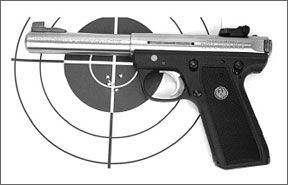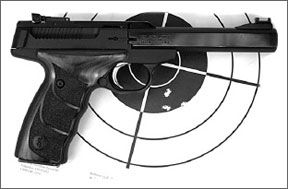In this test we will look at two .22 LR pistols that are well within reach of the youthful beginner. The guns in question were the Ruger 22/45 Mark III No. KP512MKIII, $398; and Brownings Buck Mark FLD Plus Rosewood UDX No. 051429490, $417. We wanted to know if these guns were accurate and reliable enough to provide the beginner with valuable training and keep an experienced shooter interested.

We tested each pistol for accuracy at American Shooting Centers, a public outdoor range in Houston (amshootcenters.com), and performed additional tests for endurance and reliability at Top Gun (topgunrange.com). Our choice of test ammunitions were Remington 36-grain brass-plated hollowpoints, CCI Green Tag 40-grain Competition Ammunition, and Federal American Eagle 40-grain solids. Both guns ran reliably with the Remington and CCI ammunition, but each gun had difficulty cycling the slower Federal rounds. Despite each gun suffering the same malfunction with the Federal American Eagle ammunition, we were able to record an adequate number of groups and complete our tests. Lets see what we learned.
Ruger 22/45 Mark III
No. KP512MKIII .22 LR, $398

For members of our staff, this was their first experience with a polymer-bodied 22/45 and indeed, it did feel almost impossibly narrow. Attachment of the fully adjustable rear sight seemed tenuous despite being dovetailed into place. But, together with the undercut patridge-style front sight, they formed the best sight picture. The stainless-steel receiver was drilled and tapped for the supplied scope mount. The scope mount could be attached without having to remove the sights.
The Ruger top end was all stainless steel. When pulling back the slide, the shooter had to be careful to let go before his fingers were trapped against the relief in the frame, which was sharp enough to cut.
The polymer grip frame included mock grip panels molded into place. The backstrap offered molded checkering, and on the front strap a ribbed pattern was applied. The base pad of the magazine completed the bottom of the grip without actually adding a pinky groove or additional support surface. The left-side magazine release found in the traditional location of behind the trigger guard did not let the magazine drop freely, and the rear edge of the base pad often caught on the shooters palm.
Each of the two 10-round magazines supplied offered a pull-down stud to lower the follower, for easier loading but we found grabbing the stud to be difficult. The slide lock was easy to use and so was the safety. A chamber indicator was found along the left side of the chamber consisting of a thin piece of plastic that angled out when loaded. The word “Loaded” appeared in tiny letters, which alone might seem inadequate. But the indicator did a good job of telling the finger tips the gun was ready to fire without having to take ones eyes off of the target. The Ruger 22/45 Mark III will not fire with the magazine removed.
From the shooting bench we quickly began to appreciate the Ruger 22/45 Mark III pistol. The fact that each of our shooters was initially put off by its thin grip melted with each shot. One innovation that would likely insulate this pistol from negative first impressions might be to offer alternate panels that could be applied to customize the grip.
Regarding maintenance of this pistol we referred to pages 22-23 of the owners manual for field stripping our pistol. Taking into consideration difficulties expressed in a previous evaluation of a similar Ruger pistol, we were interested in seeing how difficult this task would be. Using the recommended tools (a rubber or plastic mallet, a paper clip, and a wooden dowel), portions of the initial disassembly were difficult, but the stage in which we had to pull down on the mainspring housing was almost impossible. Finally, we were able to remove the bolt and clean the chamber, the extractor, the ejector and the breechface, but it was difficult.
Reassembly was equally trying. This was because two key parts, the hammer strut and the hammer itself needed to be in a specific position for proper assembly. The hammer strut was visible through the backstrap and needed to be pointing down the grip so it could mesh with the mainspring. Once we had a visual on the strut we were able to position it correctly. But making sure the hammer was sitting upright and not cocked with the bolt in place was troublesome. This was because the hammer was blocked from view by the bolt itself.
To bypass the magazine release safety we had to insert a magazine and keep the trigger pressed. Then, we held the gun upside down and jiggled it hoping that the hammer would fall away from the frame into its upright position. It took a few tries, and each time we failed we had to drive out the bolt stop and start over again.
The complexity of the process may be a good reason for buying a different pistol, but we found that once we had broken down and reassembled the Ruger 22/45 successfully, it didnt seem nearly as daunting.
Browning Buck Mark FLD Plus
Rosewood UDX No. 051429490
.22LR, $417
The Buck Mark was prettier than the Ruger, we thought. The beautiful wooden grip panels featured inlaid stippling, the Browning logo, and were held in place by an Allen screw on each side. This model was built on Brownings Challenger size alloy frame. The front strap featured finger grooves to match the grip panels. The trigger was gold colored. The heavy barrel was slab sided with the top surface finished with a frosted matte. The sides were a polished blue. The front sight offered a light-gathering green-colored filament front sight set in a rectangular blade that also offered definition between the edges of the rear sight notch.
The rear unit was fully adjustable for windage and elevation. No provision was made for mounting a scope, but Browning recommends the B-Square mount No. 42214, ($39 from b-square.com). This mount replaces the rear sight base and uses the original mounting screws.
Holding the Buck Mark felt more natural than the Ruger. Our staff described it as neutral or perhaps a little small. Everyone was able to get his hands around it, and our testers found it pleasurable to shoot.
The slide release and the safety levers were easy to operate. The levers offered a generous surface area and were readily available with little or no change in grip. We were able to land sub-1-inch groups with both the CCI and Remington ammunition. Some of our staff felt accuracy from the bench might have produced better results if the gun was fit with a true target front sight. Several other Browning pistols offer a patridge style front sight including the Buck Mark Contour 5.5 URX.
But others liked the increased speed of acquisition offered by the filament sight especially during plinking or hunting small game. The Browning seemed more willing to cycle the troublesome Federal rounds cleanly, but we would avoid using them nonetheless.
Field stripping began with removing the Allen screw at the rear of the sight base, then loosening the barrel mounting screw in front of the trigger guard. The barrel assembly can now be pivoted downward and off the frame. With the barrel removed, the slide can be retracted and the recoil spring removed. Only one tool, a supplied Allen wrench, was necessary for this process.
Gun Tests Recommends
Ruger 22/45 Mark III 22LR, (KP512MKIII), $398. Dont Buy. This design is legendary, but an overly complex take down/reassembly procedure might ultimately keep this gun in the closet.Browning Buck Mark FLD Plus Rosewood UDX 22LR, (051429490), $417. Buy It. Simple maintenance, great looks and accurate, this is a gun that made us want to go to shooting. GT



























